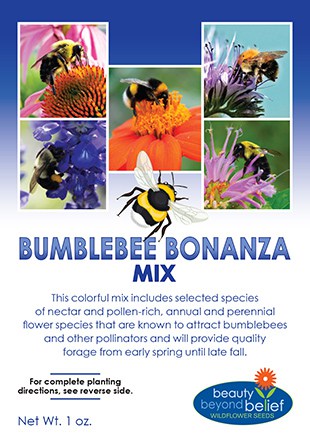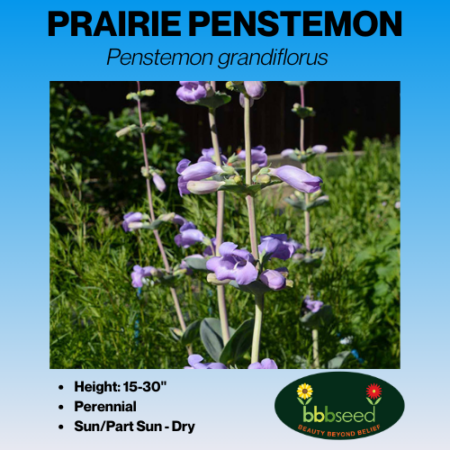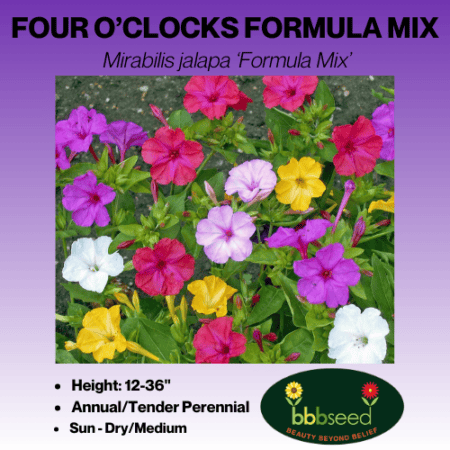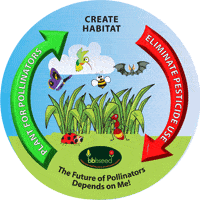Description
Bumblebee Bonanza Mix
Our Bumblebee Bonanza Mix is a colorful mix that includes specially selected species of nectar and pollen-rich, annual and perennial flowers that are known to attract bumblebees and other pollinators and will provide quality forage from early spring until late fall.
This flower seed for bumble bees mixture of annuals and perennials is designed to provide early, mid and late-season blooms to support the life cycle of the bumblebee as well as other pollinators. These flower species will do well in a variety of growing conditions and are recommended for a maintained, home-garden planting or commercial landscape. The best time for planting this mix is in the early spring, early summer, and late fall.
This Bumblebee Bonanza Mix includes:
Siberian Wallflower (Cheiranthus allionii), Rocket Larkspur (Delphinium consolida, Mixed), Balsam (Impatiens balsamina ‘Camellia Flowered Mix’), Yellow Lupine (Lupinus microcarpus densiflorus), Arroyo Lupine Lupinus succulents), Purple Coneflower (Echinacea purpurea), Dahlia-flowered Zinnia Mix (Zinnia elegans), Dwarf Mixed Cosmos (Cosmos bipinnatus, Dwarf Mixed), Gayfeather (Liatris spicata), White Prairie Clover (Dalea candida), Rocky Mountain Penstemon (Penstemon strictus), Blue Sage (Salvia farinacea), Northern Lights Snapdragon (Linaria maroccana ‘Northern Lights’), Purple Prairie Clover (Dalea purpurea), Lacy Phacelia (Phacelia tanacetifolia) and Beebalm (Monarda fistulosa). 08.30.23
Seeds per pound: 284,000
Recommended Bumblebee Bonanza Mix Seeding Rates:
1 oz. 140 sq ft.
4 oz. 575 sq ft.
8 oz. 1100 sq ft.
1 lb. 2,250 sq ft.
5 lb. 11,000 sq ft.
9 – 18 lb. /acre (1 acre = 43,560 sq ft.)
The Bumblebee Life Cycle (species Bombus)
New young queen bumblebees emerge from their birth nest at the end of summer or early autumn, mate, stock up on pollen and nectar, and then find a place to hibernate over the winter. Depending on the species, some of these queen bumblebees will appear in the spring the following year, usually around March but can be as early as February. This is sooner than honey bees and solitary bees.
At this time pollen and nectar sources are scarce, and the new queens need to find both very quickly for sustenance during these crucial days. The nectar provides energy and the pollen helps the queen replace vital body fats. The pollen also provides protein for egg production and food for the brood. The queen next needs to find a suitable place to nest. Often this is an abandoned hole, grass tussock, or even a birdhouse.
Each species is different, but generally, the queen will build a wax cup inside the nest and fill it with nectar for herself. She will make another wax cell which she will fill with pollen and lay her eggs on top. She will incubate the eggs by lying on top of them and keep them warm by vibrating her wings. The larva hatch, feed on the pollen, and go through several stages, then pupate and emerge as fully mature bumblebees.
The first to hatch are young female worker bees which help with rearing the new bumblebees and collecting forage, followed later by males and new young queens. The males typically leave the nest and the new young queens stay and feed to increase their fat reserves in order to survive the winter months in hibernation. With some species, foraging for nectar and pollen can go on until November.
Changes in agricultural techniques have meant that there are far fewer wildflowers in the landscape than there used to be, and many of our bumblebee species are struggling to survive. As bumblebees can only feed on flowers, some species have entirely disappeared from much of the countryside. However, gardens have been acting as a haven and a lifeline for bumblebees for many years and some species are now more common in urban and suburban gardens than they are in the wider countryside.
You can help with this lifeline by planting your garden with the flowers in Bumblebee Bonanza that are rich with nectar and pollen as well as safe nesting places. If you discover a bumblebee nest, please do not disturb it as they are very fragile.
You can read more about Native Bumblebees here
And information from the Xerxes Society here









Reviews
There are no reviews yet.